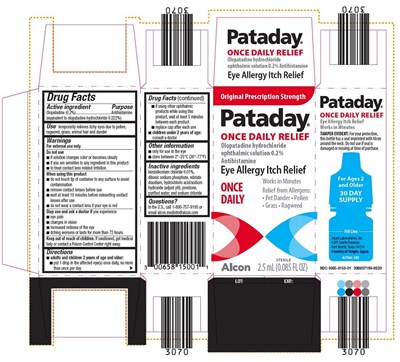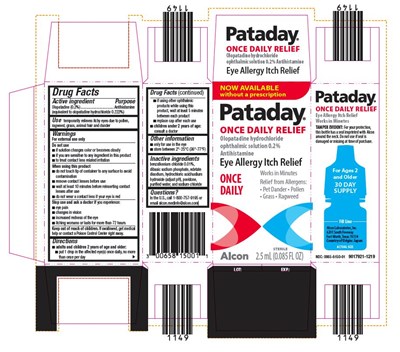Product Images Pataday Once Daily Relief
View Photos of Packaging, Labels & Appearance
Product Label Images
The following 3 images provide visual information about the product associated with Pataday Once Daily Relief NDC 0065-8150 by Alcon Laboratories, Inc., such as packaging, labeling, and the appearance of the drug itself. This resource could be helpful for medical professionals, pharmacists, and patients seeking to verify medication information and ensure they have the correct product.
300037159 0520

Pataday is a once-daily relief ophthalmic solution that contains 0.2% Olopatadine hydrochloride, an antihistamine formulated to provide relief for itchy eyes caused by allergies. The drug works within minutes of application, and the effect lasts for hours. It is essential to replace the cap after every use. The medicine is not to be used by children under two years, and people sensitive to any of the ingredients. The use of Pataday should be stopped if the allergy condition worsens or persists for over 72 hours. The medicine contains dibasic sodium phosphate, edetate disodium, and benzalkonium chloride, and it should be kept out of reach of children. The medicine comes in a 25 ml package.*
carton - carton

This is a drug called "Once Daily Relief" used for Eye Allergy Itch Relief containing the active ingredient Olopatadine Hydrochloride Ophthalmic Solution 0.2% Antihistamine, which works in minutes. It is for ages 2 and older to treat allergies caused by pet dander, pollen, grass, and ragweed. It comes in a 250ml bottle.*
label - label

This is a description of Pataday, an ophthalmic solution for eye allergies. The solution contains 0.2% olopatadine hydrochloride and comes in a 5mL (0.085 flo) sterile bottle. It provides once-a-day relief from irritating allergies and can be used by individuals who are over 2 years old. The text also includes precautions and directions for use. It is unclear what the numbers "6134" and "6121" represent.*
* The product label images have been analyzed using a combination of traditional computing and machine learning techniques. It should be noted that the descriptions provided may not be entirely accurate as they are experimental in nature. Use the information in this page at your own discretion and risk.